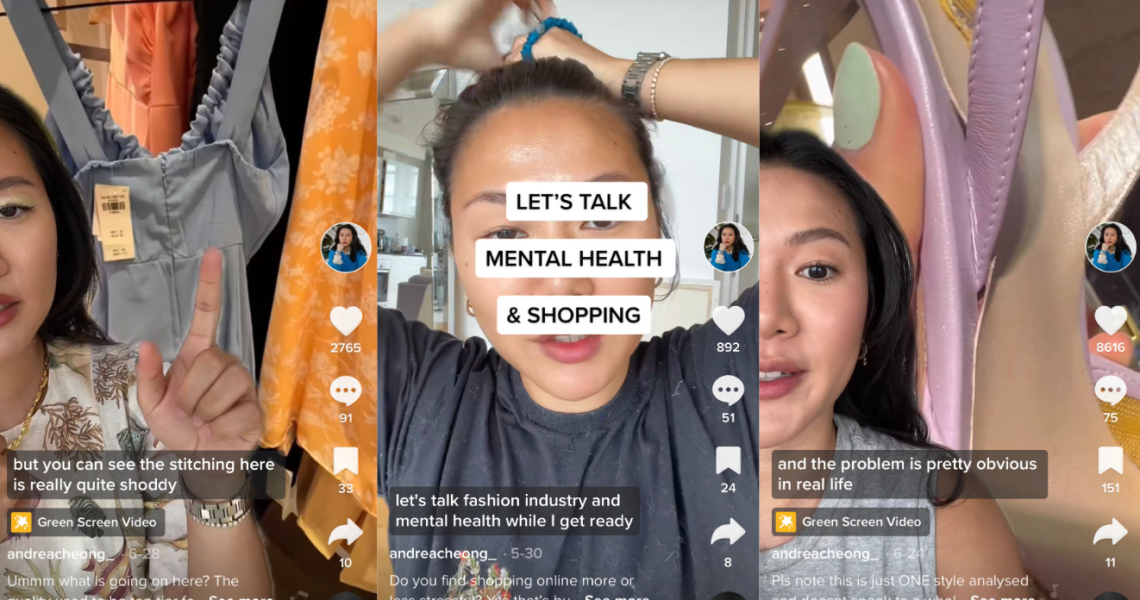Andrea Cheong, 30, has worked on many sides of the fashion industry. She’s been a journalist, worked in brand partnerships at British Vogue and held a role at a consumer trends agency. These days, however, she spends much of her time teaching her 187,000 TikTok followers how to shop mindfully. This includes showing them how to examine garments for signs of quality and shop more sustainably, as well as explaining how the quality and sustainability of one’s clothes are connected. After all, when you’re not chasing every new trend, it’s easier to avoid fast fashion and shop for things that stand the test of time.
Cheong was posting similar content on Instagram, where she now has 73,000 followers, when someone from TikTok contacted her and told her that it would also do well on TikTok. When she started to post on TikTok in 2020, the app subsequently boosted her content. “I have a very complicated relationship with social media platforms; they’re very bad for your mental health, but they can also do a lot of good. And TikTok was the one platform where I was like, ‘There are actual humans behind this,'” Cheong said, referring to the fact that TikTok employees helped her content and her message reach an audience.
Ahead, she explains how she built a fashion following on the app and what advice she gives on TikTok.
The Mindful Monday edit
“[Teaching] the Mindful Monday method [Cheong’s signature approach to shopping both mindfully and sustainably] started in 2019, and it started with Instagram Stories. A lot of people don’t understand exactly what it is, because the TikTok videos are basically only steps four and five of the method. There’s a lot of background work that goes into fixing our relationship with money and fashion.
Our relationship with fashion is super complex. It can take a large emotional and mental toll on us, not to mention a financial [toll], as well. And now that consumers are becoming more aware, we’re also adding the environmental factors to consumers’ decisions of what we should buy and where we should buy it. The Mindful Monday Method is a filter, essentially, for every single person to be able to have a healthier relationship with shopping. It’s so effective for breaking the habit of impulse shopping.”
Turning the wardrobe audit on its head
Ad position: web_incontent_pos1
“A lot of stylists love to talk about a wardrobe audit. What they never tell you to do is to look at the clothes you don’t want anymore. Because this is so revealing. Is there a common retailer here? Is there a material you clearly don’t like? … Because you shouldn’t go back there, right? We do that with exes and boyfriends, and people we’ve dated. Why don’t we do that with our clothes?”
The emotional toll of spending
“The reason I started this method is that I was spending an obscene amount of money every month — and I work in fashion, and we all know fashion doesn’t pay very well. We need to ask ourselves, ‘What’s the driving factor behind the shopping?’ A lot of people say to me, ‘I impulsively shop and I compulsively shop, and then the rest of the month, I’m broke, and then I have nothing to wear.’ And so [I recommend a] budget exercise, to inspire people to think about that. It’s not in a way that’s like, ‘Oh, you’re irresponsible.’ But it’s instead in a way to honor their mental health. For me, my financial wellness is very much tied to my mental health.”
Sustainability in practice
“We all know sustainability is a massive beast that absolutely no one has been able to get their head around. And I want to give people, customers, everybody a way to understand it for themselves, so that they’re not held to some imaginary ethical standard, and so they know what works for them and their lifestyle.
Ad position: web_incontent_pos2
People like to make [sustainability] into such a moral issue, but I’m not a better person than anyone just because I haven’t shopped at Zara for two years. If you actually follow my method, you will innately help the environment — even if it’s quite passive and even if you’re not trying to.
That’s why materials and quality are so important, because fashion’s biggest [sustainability] problem is planned obsolescence [or garments that are not made to last, in terms of quality or trend]. If everyone knew how to spot quality and knew what the expectation should be, regardless of how much you’re spending, you’d realize there’s so much you shouldn’t buy. This isn’t because it’s unethical, but it’s because it’s literally such a waste of money. It should never have been made. That’s not a comment on who made it; it’s not a comment on the workers. It’s a comment on mass production.”




